Reviewing Nation Branding Indexes: An Approach to Their Methodologies and Results
Definition
1. Introduction
2. Nation Branding Indexes
2.1. General Nation Branding Indexes
2.1.1. Anholt Ipsos Nation Brands Index (NBI)
2.1.2. Future Brand Country Index (FCI)
2.1.3. ReputationLab’s RepCore Nations
2.1.4. Good Country’s Good Country Index (GCI)
2.1.5. U.S. News’ Best Countries Ranking
2.2. Field-Specific Nation Branding Indexes
2.2.1. Brand Finance’s Global Soft Power Index
2.2.2. Bloom Consulting’s Country Brand Rankings: Tourism and Trade Editions
- The first ranking, focused on the tourism sector, measures the impact that international perception and reputation have over time in the tourism field. Its algorithm examines the tangible economic success of the countries’ tourism promotion strategies, calculated according to the international tourism receipts and growth reported by the World Tourism Organization (WTO) and/ or the different national tourism organizations (NTOs). The volume of online searches for tourism-related activities and tourist attractions in each country is also considered, while the accuracy of the NTO’s strategic positioning is reviewed by verifying the alignment between an NTO’s strategy and what international tourists are searching for. The country’s overall online presence, via website and social media analytics, is also considered [39]. The top ten positions from the latest edition of Country Brand Ranking—Tourism Edition (2024/2025) are depicted in Figure 7, below:

- The second ranking focuses on international trade information. Its data combination includes the tangible economic success of a country’s investment promotion strategy, based on inflows and growth reported by the United Nations Conference on Trade and Development (UNCTAD), and/or national investment promotion agencies (IPA). Furthermore, a dedicated tool measures the online search volume for socio-economic factors and investment-related sectors in a specific country. In addition, a country brand obtains a high score if its IPA’s strategy is shaped around the trade-related brand tags with the highest demand in terms of search volume. IPA data are also used through website analysis and social media data to determine the general visibility of the country brand [41,42]. The 2024/2025 edition of the Country Brand Ranking—Trade Edition provided the following top ten results (Figure 8).
2.2.3. International Monetary Fund’s World Economic Outlook (WEO)
2.2.4. OECD’s Better Life Index (BLI)
3. Conclusions
Author Contributions
Funding
Institutional Review Board Statement
Informed Consent Statement
Data Availability Statement
Conflicts of Interest
References
- Anholt, S. Some important distinctions in place branding. Place Brand. 2005, 1, 116–121. [Google Scholar] [CrossRef]
- Anholt, S. Making a brand travel. J. Brand Manag. 1996, 3, 357–364. [Google Scholar] [CrossRef]
- Fan, Y. Branding the nation: Towards a better understanding. Place Brand. Public Dipl. 2010, 6, 97–103. [Google Scholar] [CrossRef]
- Aronczyk, M. Branding the Nation: The Global Business of National Identity; Oxford University Press: New York, NY, USA, 2013. [Google Scholar]
- Zenker, S.; Braun, E. Questioning a “one size fits all” city brand: Developing a branded house strategy for place brand management. J. Place Manag. Dev. 2017, 10, 270–287. [Google Scholar] [CrossRef]
- Boisen, M.; Terlouw, K.; Groote, P.; Couwenberg, O. Reframing place promotion, place marketing, and place branding—Moving beyond conceptual confusion. Cities 2018, 80, 4–11. [Google Scholar] [CrossRef]
- Corbacho-Valencia, J.; Míguez-González, M.; Valderrama-Santomé, M. Percepción interna y externa de la imagen de la marca España: Análisis de métodos de evaluación. Sphera Publica 2014, 2, 82–99. [Google Scholar]
- Vasist, P.N.; Krishnan, S. Country branding in post-truth Era: A configural narrative. J. Destin. Mark. Manag. 2024, 32, 100854. [Google Scholar] [CrossRef]
- Govers, R.; Go, F.M. Place Branding: Glocal, Virtual and Physical Identities, Constructed, Imagined and Experienced; Palgrave Macmillan: Basingstoke, UK, 2009. [Google Scholar]
- Govers, R. Virtual Tourism Destination Image: Glocal Identities Constructed, Perceived and Experienced; Erasmus Research Institute of Management (ERIM): Rotterdam, The Netherlands, 2005. [Google Scholar]
- Mariutti, F.; Tench, R. How does Brazil measure up? Comparing rankings through the lenses of nation brand indexes. Place Brand. Public Dipl. 2015, 12, 17–31. [Google Scholar] [CrossRef]
- Lee, R.; Lee, Y. The role of nation brand in attracting foreign direct investments: A case study of Korea. Int. Mark. Rev. 2021, 38, 124–140. [Google Scholar] [CrossRef]
- Steenkamp, J.B. Building strong nation brands. Int. Mark. Rev. 2021, 38, 6–18. [Google Scholar] [CrossRef]
- Lahrech, A.; Aldabbas, H.; Juusola, K. Determining the predictive importance of the core dimensions of nation brands. J. Prod. Brand Manag. 2023, 32, 1207–1219. [Google Scholar] [CrossRef]
- Dineri, E.; Bilginer Özsaatcı, F.G.; Kılıç, Y.; Çiğdem, S.; Sayar, G. Unveiling the Power of Nation Branding: Exploring the Impact of Economic Factors on Global Image Perception. Sustainability 2024, 16, 6950. [Google Scholar] [CrossRef]
- Juusola, K.; Lahrech, A.; AlDabbas, H. Exploring the Relationship between Innovation Efficiency and Nation Brand Strength: A Panel Study. J. Knowl. Econ. 2024. [Google Scholar] [CrossRef]
- The Place Brand Observer. Anholt Nation Brands Index (NBI) 2024: Key Highlights and Trends. 17 December 2024. Available online: https://placebrandobserver.com/anholt-nation-brands-index-nbi-2024/ (accessed on 15 February 2025).
- The Scottish Government. The Anholt Nation Brands Index: 2024 Report for Scotland Methodology Report. 23 January 2025. Available online: https://www.gov.scot/publications/anholt-nation-brands-index-2024-report-scotland-methodology-report/pages/4/ (accessed on 15 February 2025).
- Ipsos. The Anholt-Ipsos Nation Brands Index. 2023. Available online: https://www.ipsos.com/sites/default/files/ct/news/documents/2023-10/NBI-2023-Press-Release-Supplemental-Deck-December-23.pdf (accessed on 10 December 2024).
- QRi Consulting. FutureBrand Country Index 2020. 12 November 2020. Available online: https://www.qriconsulting.com/futurebrand-country-index-2020/ (accessed on 10 December 2024).
- Future Brand. Country Index 2020. 2020. Available online: https://www.futurebrand.com/futurebrand-country-index-2020 (accessed on 16 January 2025).
- Hitz, N.; Schwaiger, M.; Gabel, J. How to measure and manage country reputation. Int. J. Advert. 2024, 1–31. [Google Scholar] [CrossRef]
- Foro de Marcas Renombradas. Reflexiones Sobre la Marca España a la Luz de Los Datos. 6 January 2023. Available online: https://www.marcasrenombradas.com/de_cerca/reflexiones-sobre-la-marca-espana-a-la-luz-de-los-datos/ (accessed on 5 February 2025).
- En Segundos Panamá. Reputación de Panamá es Moderada Entre la Opinión Pública de Países del G7. 19 October 2022. Available online: https://ensegundos.com.pa/tag/repcore-nations/ (accessed on 5 February 2025).
- Abenia, J.R. ¿Mejora o Empeora la Reputación de tu País? Cultura RSC. 23 May 2024. Available online: https://www.culturarsc.com/mejora-o-empeora-la-reputacion-de-tu-pais/ (accessed on 5 February 2025).
- Elcano Royal Institute. España en el Mundo en 2024: Perspectivas y Desafíos. 2024. Available online: https://media.realinstitutoelcano.org/wp-content/uploads/2024/01/policy-paper-espana-en-mundo-2024-perspectivas-desafios.pdf (accessed on 10 December 2024).
- City Nation Place. The Role of Sustainability in Building a Strong Country’s Reputation. 26 March 2024. Available online: https://www.citynationplace.com/the-role-of-sustainability-in-building-a-strong-countrys-reputation-value-creating-strategy-for-country-brand-managers (accessed on 5 February 2025).
- The Place Brand Observer. RepCore Nations 2024 Ranking: Switzerland Leads, Israel Declines. 27 November 2024. Available online: https://placebrandobserver.com/repcore-nations-2024-ranking-summary/ (accessed on 5 February 2025).
- Wang, B. Social Development: Which Country Is the Best Country. In Public Value and Social Development. The Frontier of Public Administration in China; Springer: Singapore, 2022. [Google Scholar] [CrossRef]
- Good Country. Good Country—What’s All This About, Then? 2025. Available online: https://goodcountry.org/index/your-questions/background/whats-all-this-about-then/ (accessed on 25 February 2025).
- Good Country. Good Country Index—How Is It Compiled? 2025. Available online: https://goodcountry.org/index/your-questions/how-is-it-compiled/how-is-the-good-country-index-compiled/ (accessed on 25 February 2025).
- The Place Brand Observer. Good Country Index 2024: Finland Leads, Followed by Sweden and Germany. 18 December 2024. Available online: https://placebrandobserver.com/good-country-index-2024/ (accessed on 25 February 2025).
- Good Country. Good Country Index 1.6 Results. 2025. Available online: https://index.goodcountry.org/ (accessed on 25 February 2025).
- US News. Frequently Asked Questions: 2024 Best Countries. 2024. Available online: https://www.usnews.com/news/best-countries/articles/frequently-asked-questions (accessed on 11 January 2025).
- US News. 2024 Best Countries—Methodology. 2024. Available online: https://www.usnews.com/news/best-countries/articles/methodology (accessed on 11 January 2025).
- Brandirectory. Global Soft Power Index. Available online: https://brandirectory.com/softpower (accessed on 11 January 2025).
- Brand Finance. Thailand Moves Up by One Rank to 39th in Global Soft Power Index 2025. 25 February 2025. Available online: https://brandfinance.com/press-releases/thailand-moves-up-by-one-rank-to-39th-in-global-soft-power-index-2025 (accessed on 25 February 2025).
- Brand Finance. Global Soft Power Index 2025. Available online: https://static.brandirectory.com/reports/brand-finance-soft-power-index-2025-digital.pdf (accessed on 25 February 2025).
- Bloom Consulting. Branding-Country Brand Ranking. Available online: https://www.bloom-consulting.com/en/country-brand-ranking (accessed on 15 January 2025).
- Bloom Consulting. Country Brand Ranking—Tourism Edition 2024/2025. Available online: https://www.bloom-consulting.com/en/pdf/rankings/Bloom_Consulting_Country_Brand_Ranking_Tourism.pdf (accessed on 15 January 2025).
- Bloom Consulting. Highlights of the Country Brand Ranking 2024|2025 Tourism Edition. 11 June 2024. Available online: https://www.bloom-consulting.com/journal/highlights-of-the-country-brand-ranking-2024-2025-tourism-edition/ (accessed on 15 January 2025).
- Bloom Consulting. Country Brand Ranking—Trade Edition 2024/2025. Available online: https://www.bloom-consulting.com/en/pdf/rankings/Bloom_Consulting_Country_Brand_Ranking_Trade.pdf (accessed on 15 January 2025).
- Bloom Consulting. Highlights of the Country Brand Ranking 2024|2025 Trade Edition. 11 June 2024. Available online: https://www.bloom-consulting.com/journal/highlights-of-the-country-brand-ranking-2024-2025-trade-edition/ (accessed on 15 January 2025).
- International Monetary Fund. GDP, Current Prices. 2025. Available online: https://www.imf.org/external/datamapper/NGDPD@WEO/OEMDC/ADVEC/WEOWORLD (accessed on 25 February 2025).
- International Monetary Fund. World Economic Outlook. Available online: https://www.imf.org/en/Publications/WEO?page=2 (accessed on 15 January 2025).
- OECD. The OECD: Better Policies for Better Lives. 2024. Available online: https://www.oecd.org/en/about.html (accessed on 25 February 2025).
- OECD. How’s Life? 2020: Measuring Well-Being; OECD Publishing: Paris, France, 2020. [Google Scholar] [CrossRef]
- OECD. Executive Summary—Better Life Index. 2014. Available online: https://www.oecdbetterlifeindex.org/media/bli/documents/BLI_executive_summary_2014.pdf (accessed on 25 February 2025).
- OECD. Better Life Index. Available online: https://www.oecdbetterlifeindex.org/#/55555555555/ (accessed on 25 February 2025).
- OECD. What Is the Better Life Index? Available online: https://www.oecdbetterlifeindex.org/about/better-life-initiative/ (accessed on 25 February 2025).
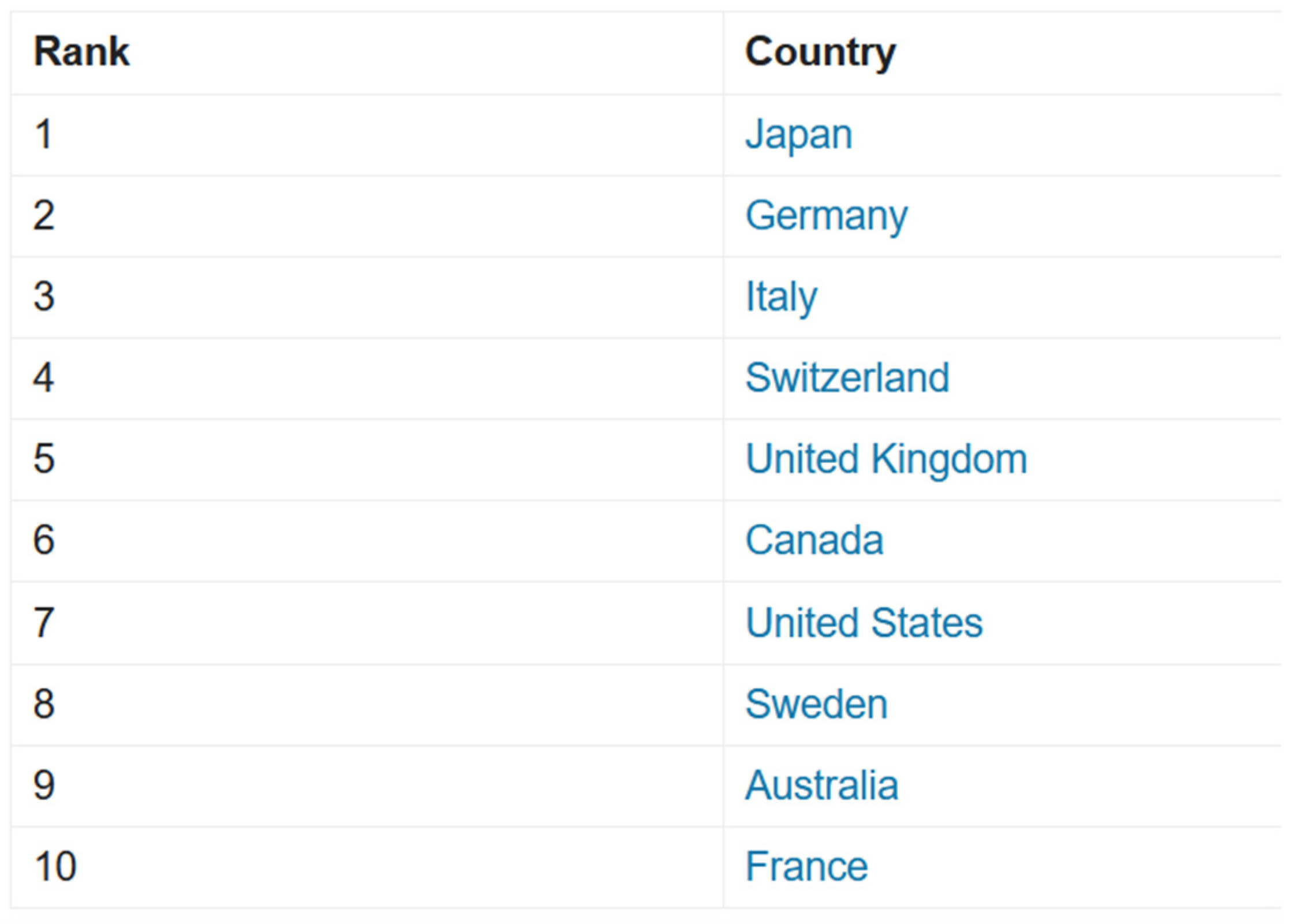
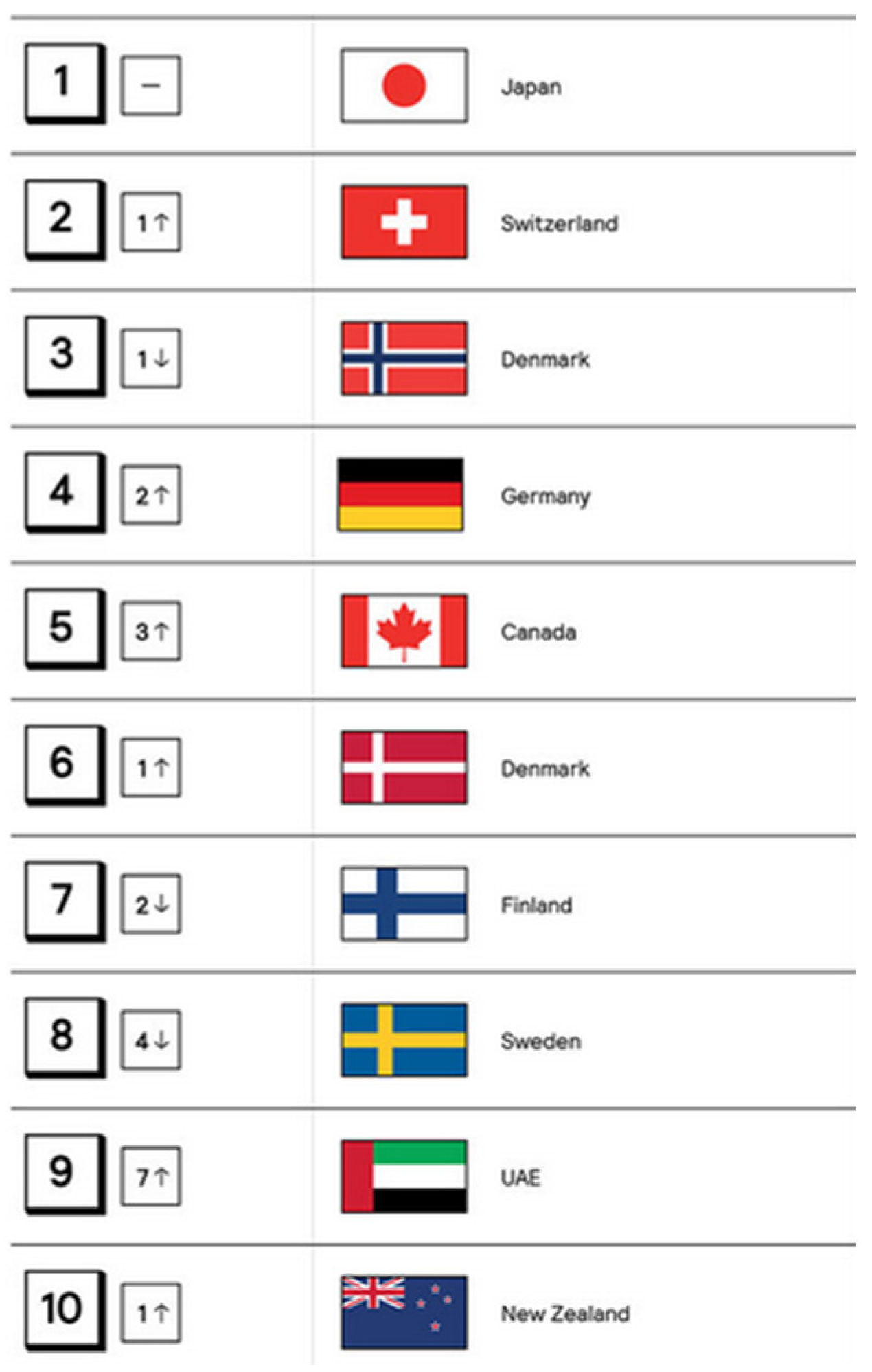

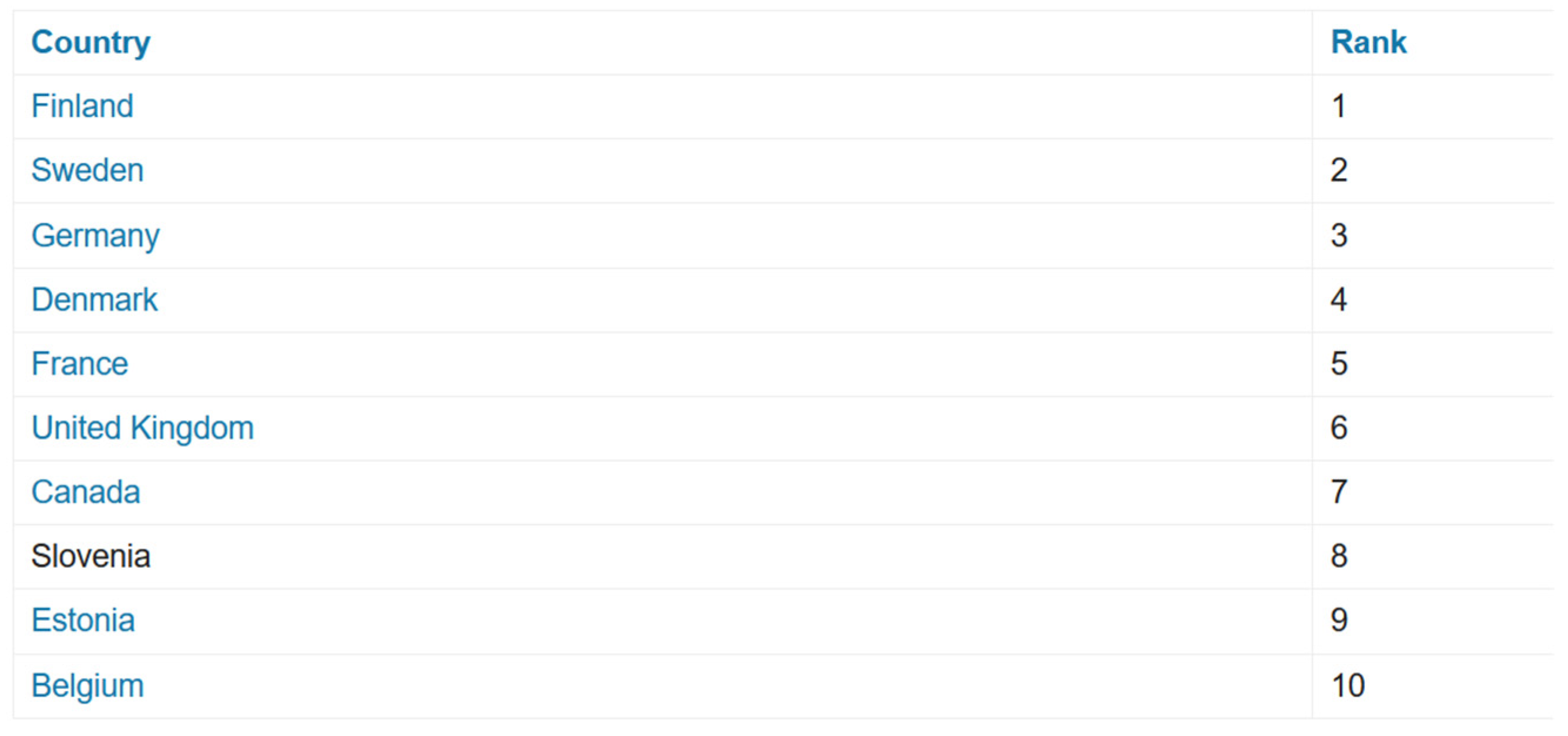
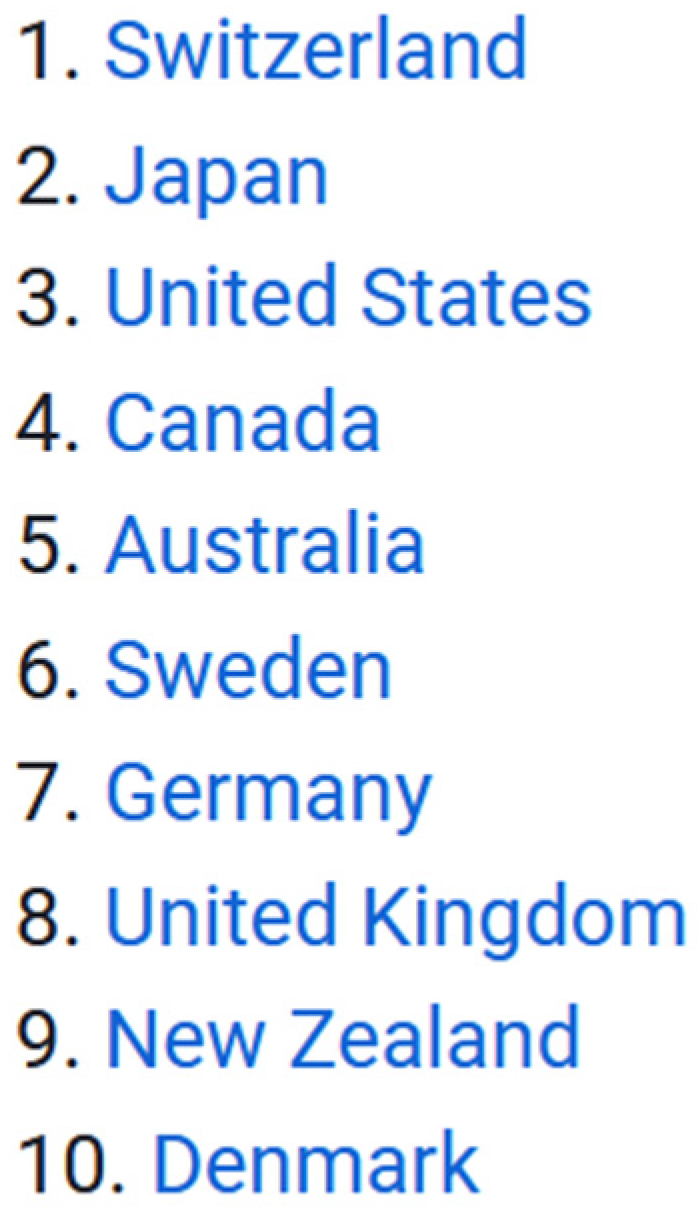
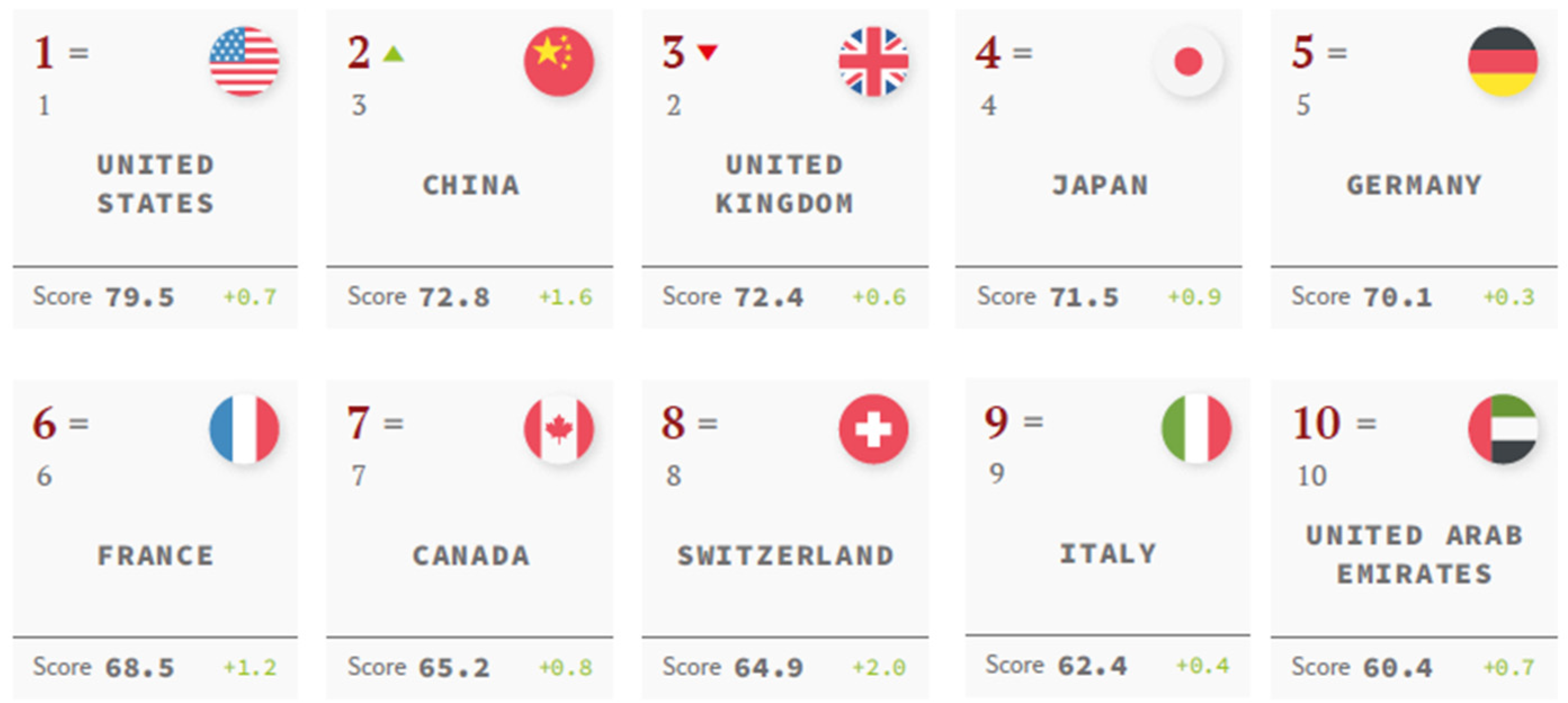

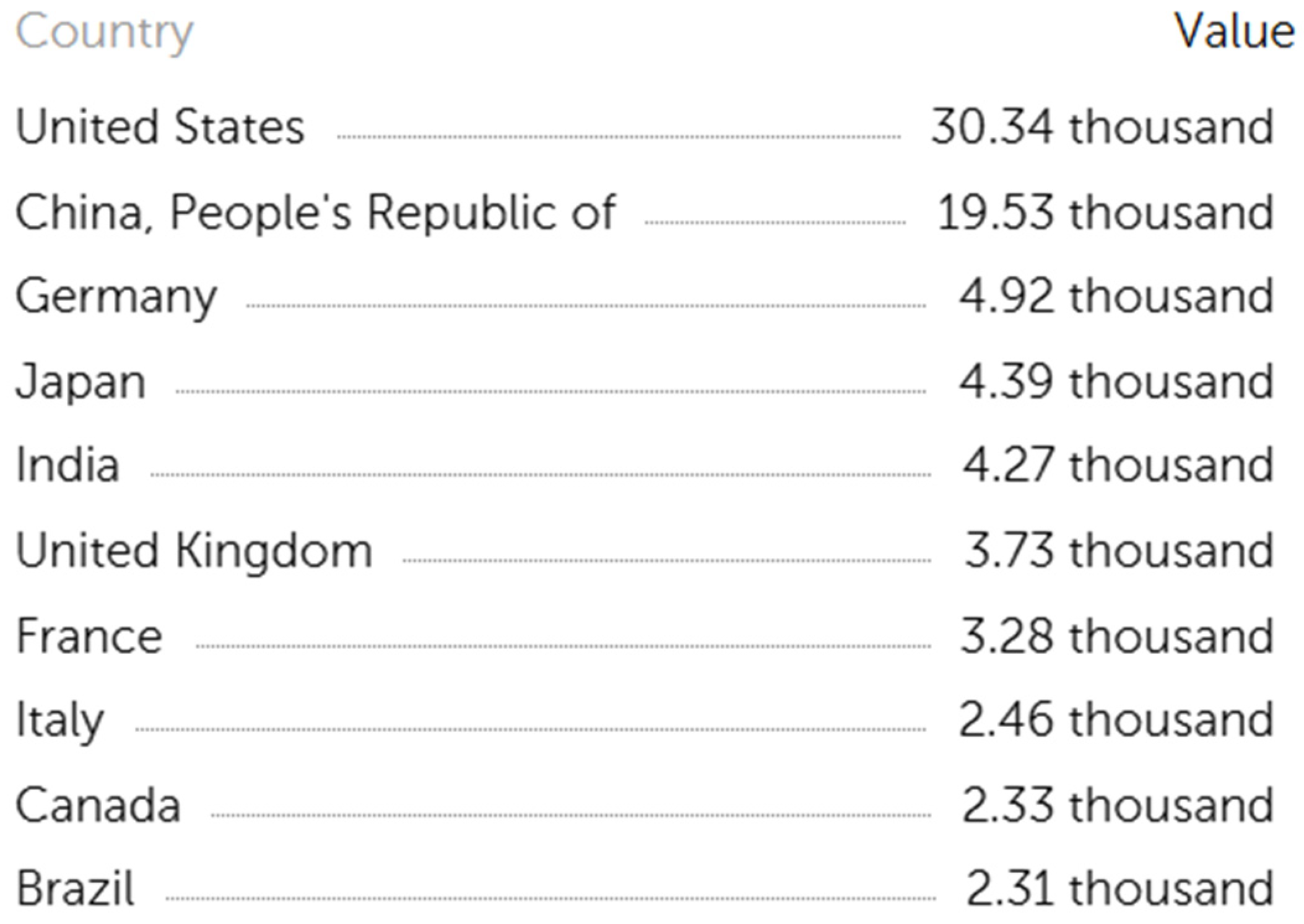

Disclaimer/Publisher’s Note: The statements, opinions and data contained in all publications are solely those of the individual author(s) and contributor(s) and not of MDPI and/or the editor(s). MDPI and/or the editor(s) disclaim responsibility for any injury to people or property resulting from any ideas, methods, instructions or products referred to in the content. |
© 2025 by the authors. Licensee MDPI, Basel, Switzerland. This article is an open access article distributed under the terms and conditions of the Creative Commons Attribution (CC BY) license (https://creativecommons.org/licenses/by/4.0/).
Share and Cite
Maiz-Bar, C.; Molares-Cardoso, J.; Badenes-Pla, V. Reviewing Nation Branding Indexes: An Approach to Their Methodologies and Results. Encyclopedia 2025, 5, 43. https://doi.org/10.3390/encyclopedia5020043
Maiz-Bar C, Molares-Cardoso J, Badenes-Pla V. Reviewing Nation Branding Indexes: An Approach to Their Methodologies and Results. Encyclopedia. 2025; 5(2):43. https://doi.org/10.3390/encyclopedia5020043
Chicago/Turabian StyleMaiz-Bar, Carmen, Julinda Molares-Cardoso, and Vicente Badenes-Pla. 2025. "Reviewing Nation Branding Indexes: An Approach to Their Methodologies and Results" Encyclopedia 5, no. 2: 43. https://doi.org/10.3390/encyclopedia5020043
APA StyleMaiz-Bar, C., Molares-Cardoso, J., & Badenes-Pla, V. (2025). Reviewing Nation Branding Indexes: An Approach to Their Methodologies and Results. Encyclopedia, 5(2), 43. https://doi.org/10.3390/encyclopedia5020043





